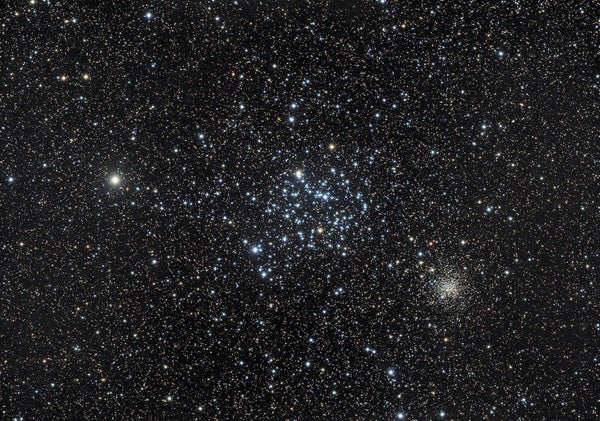One of winter’s finest open clusters, M35 is tucked inside the southwestern corner of Gemini the Twins. It was first found in either 1745 or 1746 by Swiss astronomer Philippe Loys de Chéseaux, although his observations were never widely circulated. English astronomer John Bevis bumped into it a few years later. Bevis’ published discovery led Charles Messier to observe the object in August 1764, after which he added it as the 35th entry in his catalog. He recalled the view of M35 as a “cluster of very small stars, near the left foot of Castor.”
Specifically, M35 is located a little more than 2° northwest of Propus (Eta [η] Geminorum). It looks as if Castor is about to kick M35 right through the horns of Taurus the Bull. Perhaps astronomers should nickname it the Soccer Ball Cluster. Goal!
Shining at 5th magnitude, you can glimpse M35 with naked eyes, given pristine sky conditions. But even without a great sky, the open cluster is easily seen through binoculars. Some 10x50s will resolve about eight or nine points of light across the misty glow of other, unresolved cluster stars.
If you aim a telescope its way, M35 explodes into stardust, with dozens of dazzling suns strewn across a field some 28′ wide. That means that low power paired with wide-field eyepieces will deliver the most satisfying results.
All told, M35 claims more than 400 stellar members. Most of those are white or blue-white main sequence stars that are still fusing hydrogen into helium in their cores. You may also notice a few stars tinted with subtle shades of yellow or orange. Those have evolved off the main sequence and are no longer producing energy through hydrogen fusion in their cores.
A second rich open cluster known as NGC 2158 lies about 0.5° southwest of M35. Messier did not document this one, but it is bright enough to be visible as a vague glow through a 4-inch scope. Though they appear next to each other in the sky, M35 is about 2,800 light-years away, while NGC 2158 is about 10,000 light-years beyond it.
Make sure to explore Astronomy’s full list of 101 cosmic objects you must see. New entries will be added each week throughout 2022.
To get the latest astronomical news and observing content delivered directly to your door, subscribe to Astronomy magazine today!










